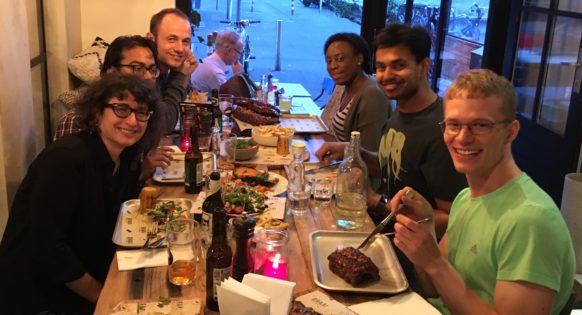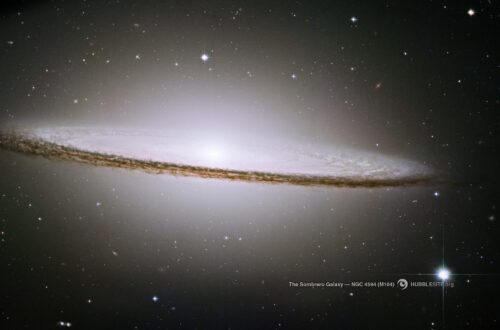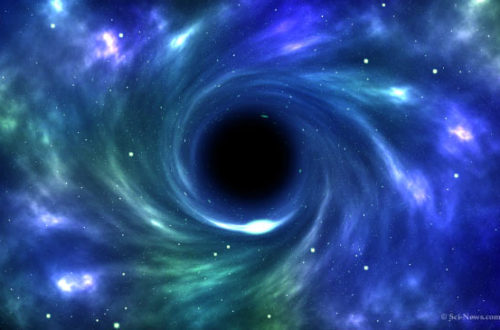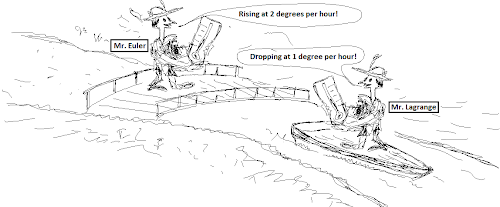As this picture shows, nothing seems to make members of my group happier than a massive rack of ribs (well except for me and Atul, who are eating the veggie options…). That, and a visit from our collaborator Sasha Tchekhovskoy, from Northwestern University! (left to right: me, Koushik Chatterjee, Prof. Sasha Tchekhovskoy, Dr. Gibwa Musoke, Dr. Atul Chhotray, Matthew Liska)

One of the things people often ask me is why I work here rather than the US, where I’m from. There are several answers to that, the main one being that University of Amsterdam is one of the best places in the world for both of the things I do (compact object studies and astroparticle physics), which is rare, plus it’s also a great city to live in. Other answers include the fact that I have a scientist husband and finding two good, independent jobs in our field is challenging, and of the possibilities we were offered the one in the Netherlands suited us best. But yet another answer could be something like “Why not? science is international and no matter where I work, I will collaborate with people from around the globe!”. Sasha’s visit is a great example of how such projects work, so let me tell a little story:
Sasha and I got to know each other, as is often the case, through international conferences where researchers gather to discuss their latest findings and debate ideas. These meetings are part of our job and are one of the aspects (besides the science itself) that attracted me to scientific research in the first place, because I really enjoy traveling to new places and meeting interesting people. So we started discussing ideas and possible collaborations, and then ended up working on a paper together (see here if you’re curious) with two other collaborators we knew in common: Dr. Jason Dexter (who led the project, and starts as a prof at UC Boulder any minute now!) and Prof. Jonathan McKinney of University of Maryland. It was fun to work with Sasha, who is a computational astrophysicist specializing in numerical simulations of black holes and their outflows, so when a student came to me interested in doing a Master’s project in my group, but saying he really wanted it to have a GPU programming component, I thought it could be a fun project to approach him with. Sasha had worked a lot already with a GRMHD code (read other posts in our blog to learn what that means, but basically it’s a tool we use to calculate the commplex behavior of magnetized plasma in the strong gravity around black holes) called HARM. He had already done quite a bit of development on HARM over the years, so we thought it would be fun to have this student, Matthew Liska, take a crack at getting the public version of the code to run on GPUs, which would speed it up significantly. The rest is history: Matthew got it working within weeks and then managed to speed the code up by almost a factor of 100. Since then Matthew has done significantly more development on what is now a new GPU-based code, HAMR (see here for the first paper), that became his MSc thesis project. This in turn opened up a new collaboration between my group and the group of Prof. Michiel van der Klis here at UvA, where Matthew is now a PhD student, and Sasha’s group at Northwestern University in Evanston, IL. Sasha is now the coadvisor of two University of Amsterdam PhD students: Matthew, and Koushik Chatterjee in my group, and will also help supervise the HAMR related project of Dr. DooSoo Yoon, who joins our group here as a postdoc next week!
Thus science knows no boundaries, in that sense it’s a far better model for how the world could work compared to the nationalism we’re seeing across the globe. I’m an American living and working successfully in the EU, Sasha is originally Russian but now a naturalized US citizen: we are both very good examples of successful immigrants! And my family actually emigrated from East Europe so it’s all come full circle in some sense. We are working together via students and postdocs from the Netherlands (but Matthew’s family had immigrated from the Czech Republic), India, UK and Korea so far. And this entirely new research line that has yielded already over ten new projects in the pipeline, all started because two people got to talking at an international conference! This is just one of the many reasons why science is so awesome, and why Sasha now comes here on a semi-regular basis, and why our group members also travel to visit him in the US. Plus it gives us an excuse to celebrate, with festive group dinners! So yes, that’s a bit rambling, but it seemed like a good excuse to post a nice picture along with a bit of a lesson in international collaboration for non-academics.



